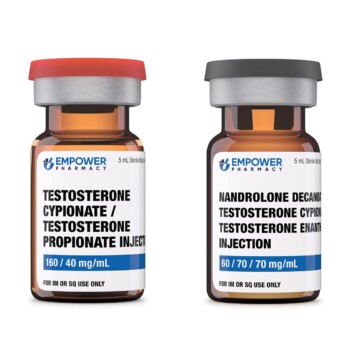Article Summary
Millions of women experience hormone-related health conditions, affected by aging, pregnancy, stress, and genetics. Hormone Replacement Therapy offers relief for various symptoms, including decreased libido, migraines, and muscle pain. Customized therapy and rigorous quality control ensure safe and effective treatment, particularly during menopause, although alternatives should be considered based on individual health and lifestyle factors.Millions of women from every background experience some form of hormone-related health condition during their lifetimes.[1][2] The natural process of aging makes visible a myriad of symptoms, especially during the menopausal transition years. However, fluctuating and dropping hormone levels can also occur at any age as a result of pregnancy, stress, use of birth control, genetics, or lifestyle.[2] Hormone Replacement Therapy (HRT) offers a patient-specific approach to providing both short-term and long-term relief. Treatable symptoms include:[1][2]
- Decreased libido, vaginal dryness, painful sexual intercourse
- Endometriosis, fibrocystic breasts
- Migraines, hot flashes, night sweats, rapid heartbeat, cardiovascular complications Depression, fatigue, tiredness, moodiness, irritability, sleeping disturbances, weight gain
- Muscle pain, joint pain, back pain, thinning of bone structure
Mass-Produced HRT Formulations: Useful, but Limited
Many hormones produced by our pharmacy have the exact same chemical structure as human hormones. The body recognizes them and allows them to mimic the function of the hormones the body produces on its own.[3] There are many mass-produced hormone treatments on the market today. However, every woman’s body – and her individual hormonal makeup – is different and each requires a unique balance of hormones. That’s why more women are turning to custom compounded HRT’s for their hormone replacement needs.[4] Among the common ingredients used in formulations for women are estradiol, progesterone, testosterone, and dehydroepiandrosterone (DHEA).[3][5]
Working with you and your physician, our compounding pharmacists will assist in evaluating your serum or saliva tests and hormone evaluation worksheet. By studying and interpreting the results, your care team will determine an individualized course of treatment for you. Then, with your healthcare provider’s prescription, we can prepare hormones in a variety of strengths and dosage forms, including:
- Injectables
- Sublingual tablets or troches
- Capsules
- Gels
- Suppositories
- Topical or vaginal creams
Menopause Causes
Hormones are powerful chemicals and for therapies to be effective it is essential that they are compounded properly and accurately.[4] Empower Pharmacy employs rigorous quality control measures adhering to USP guidelines to provide the highest level of patient care available.
Menopause is a naturally occurring biologic process in females, generally occurring in from age 45 to 55. Menopause occurs after the last ovulation marking the end of the fertile period of a female’s life. It is defined as the permanent end of menses and fertility occurring 12 months after a patients last menstruation. During menopause the body regulates itself to acquire a new hormonal balance, spanning for the rest of the lifespan of the female.
When a female goes through menopause the ovaries stop producing eggs and fewer hormones (estrogen and progesterone); menstrual periods generally become either more closely or more widely spaced, but may even come to a sudden stop. This reduction in potent and active sex hormones, and their downstream biological effects, cause a plethora of changes in physiological processes. An irregularity in menstrual cycles can occur for one to three years. Even though a natural process and not a medical illness, it still can have dramatic effects on a women’s mental and physical health. These effects vary dramatically from one patient to another and are primarily caused by the changes in estrogen and progesterone.
Menopause Symptoms
The effect of the underproduction of hormones, and other biological molecules, by the ovaries manifest in several unpleasant symptoms. These symptoms can be divided into two categories physical and psychological. Physical symptoms include irregular menstrual periods, hot flashes, night sweats, heavy sweating, fatigue, muscle aches, heart palpitations, headaches, dizziness, sore breasts, sensitive skin, dry hair, hair loss, prolapse, vaginal drying, painful sexual intercourse, vaginal discharge, loss of libido, urine tract infections, urinary incontinence, and an increase in osteoporosis. Psychological symptoms include mood swings, fatigue, apathy, anxiety, and depression.
Menopause Treatments
A common treatment used for the symptoms of menopause is hormone replacement therapy.[6] Hormone replacement therapy mimics the human body’s natural production of those hormones in order to reduce the symptoms associated with dramatic swings in hormone concentrations during menopause.[7][8] Since these treatments are patient specific and vary from patient to patient many different formulations of hormone therapy can be made by compounding pharmacies to meet these individual needs. Hormones of all strengths and concentrations can be put into oral capsules, topical creams or gels, vaginal creams, suppositories, injections, and sublingual lozenges.[9] There are also other prescription alternatives to hormonal therapy that may work for some women. Patients have found benefit in reduction of symptoms with the use of anti-depressants, anti-hypertensive and also anti-seizure medications.[10][11]
The treatment of these symptoms can be accomplished by replacing the hormones that the underperforming ovaries fail to produce.[12] This therapy is referred to as hormone replacement therapy (HRT). The body naturally stops producing these hormones because its genetics dictate the time for reproduction is over. Even though the body is programmed this way, replacing hormones in the appropriate amounts can maintain a comfortable balance that is beneficial to the female.
Vasomotor symptoms are usually described as night sweats, hot flashes, and flushes. Hormone replacement therapy can reduce these vasomotor symptoms in postmenopausal and perimenopausal women by 65% and 90%, respectively.[13]
There are many different drugs prescribed to treat the symptoms of menopause but not many drugs to treat the underlying causes of menopause.[11][14]
The lack of hormonal signals, and in balance initiates the biological processes that produce the symptoms mentioned above.[15] Therapies to treat and replace the hormonal signals are readily available from qualified physicians.
Therapy includes mono or combination therapy of the hormones progesterone, estradiol and in some cases low dose testosterone. Even though estrogens are referred to as the female hormones, every female also is genetically set to produce testosterone in small amounts. Serum levels of testosterone also drop as estrogen concentrations decrease. Hormone replacement therapy replaces the hormones that the ovaries fail to produce naturally. Generally, if the risk reward ratio of hormone replacement therapy is in the favor of the patient’s health, due to the disruption from menopausal symptoms, hormone replacement therapy might be considered by your physician.[16]
Hormone replacement therapy is not for all patients, many patients with pre-existing conditions should consider alternatives if concerned with adverse effects. The benefits of a comfortable and healthy lifestyle should be weighed against the adverse side effects of hormone replacement therapy by your physician.
In recent news, hormone replacement therapy has become the subject of debate among medical communities.[17] A large shift in prescribing patterns recently occurred in the general physician prescribing population. When hormone replacement therapy was first prescribed to treat menopausal symptoms, it was generally regarded as safe for all, almost equivalent to consumption of over-the-counter daily vitamins and supplements. Generally, physicians prescribed hormone replacement therapy because of the dramatic effect on the mood and well-being.[18] However, dramatic psychological and physical beneficial effects came at a large cost to some. Few women prescribed hormone replacement experienced moderate to severe side effects. These effects did not occur in the large majority of women, but were at a large enough percentage to warrant other drugs with less side effects as treatment for the symptoms of menopause. Many women continue to take hormone replacement therapy for treatment of menopausal symptoms.
Predisposition to disease plays a large part in determining if a patient is an appropriate candidate for hormone replacement therapy.[19] Additionally, lifestyle and dietary changes are considered the first line of treatment for healthily undergoing the changes of menopause.
Secondarily, medications with outstanding safety profiles are considered for the alleviation of menopausal symptoms before hormonal therapy is considered. However, contrary to popular prescribing patterns, some physicians prefer to utilize hormone replacement therapy as a primary treatment for menopausal symptoms, these physicians generally approach cautiously. Physicians using hormone replacement therapy as a primary treatment thoroughly evaluate a patient’s pre-disposition to adverse side effects, determine precise hormone dosages, and closely monitor the patient during initiation and continuation of therapy. These measures increase the safety of hormone replacement therapy, a knowledgeable physician can monitor a patient and determine physiological changes occurring from the hormones administered. If physiological changes are determined to be dangerous to the patient’s health the prescribing physician can cease hormone therapy. The serum markers indicative of adverse effects should be monitored by a prescribing physician. Generally, these biomarkers include cardiovascular, liver, and general metabolic proteins and small molecules associated with the adverse side effects of estrogen, progesterone and testosterone administration.[20] Negative effects on inflammatory markers biomarkers include, E-selectin, cell adhesion molecules, monocyte chemoattractant protein-1, and tumor necrosis factor-alpha, inconsistent effects on interleukin-6, and stimulatory effects on vasoprotective cytokine, such as the transforming growth factor-alpha.[21][22][23] However, women who receive 2-3 years of HRT after menopause do not have increased mortality, in contrast cardiovascular benefits are apparent when compared to those who had not been treated with HRT.[24]
- Miller M, et al. “Theoretical basis for the benefit of postmenopausal estrogen substitution.” Experimental Gerontology. 1999;34:587-604.
- Bredell E. Menopause. Manna e-Book. April 2013.
- Smith P. “A Comprehensive Look at Hormones and the Effects of hormone Replacement”.What You Must Know About Women’s Hormones: Your Guide to Natural Hormone Treatment for PMS, Menopause, Osteoporosis, PCOS, and More. Square One Publishers. 28 Nov 2009: Chapter 41.
- J Clin Endocrinol Metab. 2012 Mar;97(3):756-9. Misconception and concerns about bioidentical hormones used for custom-compounded hormone therapy. Bhavnani BR, Stanczyk FZ.
- Mayo Clin Proc. 2011 Jul;86(7):673-80. Bioidentical hormone therapy Files JA, Ko MG, Pruthi S.
- Pinkerton, J.V., D.W. Stovall, and R.S. Kightlinger, Advances in the treatment of menopausal symptoms. Womens Health (Lond Engl), 2009. 5(4): p. 361-384; quiz 383-4.
- Pachman, D.R., J.M. Jones, and C.L. Loprinzi, Management of menopause-associated vasomotor symptoms: Current treatment options, challenges and future directions. Int J Womens Health, 2010. 2: p. 123-35.
- Files, J.A., M.G. Ko, and S. Pruthi, Bioidentical hormone therapy. Mayo Clin Proc, 2011. 86(7): p. 673-80, quiz 680.
- Sood, R., et al., Prescribing menopausal hormone therapy: an evidence-based approach. Int J Womens Health, 2014. 6: p. 47-57.
- North American Menopause, S., Treatment of menopause-associated vasomotor symptoms: position statement of The North American Menopause Society. Menopause, 2004. 11(1): p. 11-33.
- Albertazzi, P., A review of non-hormonal options for the relief of menopausal symptoms. Treat Endocrinol, 2006. 5(2): p. 101-13.
- Canderelli, R., et al., Benefits of hormone replacement therapy in postmenopausal women. J Am Acad Nurse Pract, 2007. 19(12): p. 635-41.
- MacLennan, A., S. Lester, and V. Moore, Oral estrogen replacement therapy versus placebo for hot flushes: a systematic review. Climacteric, 2001. 4(1): p. 58-74.
- Oztas, E. and G. Kurtay, Effects of raloxifene on serum macrophage colony-stimulating factor and interleukin-18 levels in postmenopausal women younger than 60 years. Menopause, 2010. 17(6): p. 1188-93.
- Burger, H.G., et al., Cycle and hormone changes during perimenopause: the key role of ovarian function. Menopause, 2008. 15(4 Pt 1): p. 603-12.
- A decision tree for the use of estrogen replacement therapy or hormone replacement therapy in postmenopausal women: consensus opinion of The North American Menopause Society. Menopause, 2000. 7(2): p. 76-86.
- Martin, K.A. and J.E. Manson, Approach to the patient with menopausal symptoms. J Clin Endocrinol Metab, 2008. 93(12): p. 4567-75.
- Zweifel, J.E. and W.H. O’Brien, A meta-analysis of the effect of hormone replacement therapy upon depressed mood. Psychoneuroendocrinology, 1997. 22(3): p. 189-212.
- Rozenberg, S., et al., Educating patients about the benefits and drawbacks of hormone replacement therapy. Drugs Aging, 1998. 13(1): p. 33-41.
- Genant, H.K., et al., Low-dose esterified estrogen therapy: effects on bone, plasma estradiol concentrations, endometrium, and lipid levels. Estratab/Osteoporosis Study Group. Arch Intern Med, 1997. 157(22): p. 2609-15.
- Georgiadou, P. and E. Sbarouni, Effect of hormone replacement therapy on inflammatory biomarkers. Adv Clin Chem, 2009. 47: p. 59-93.
- Karim, R., et al., Associations between markers of inflammation and physiological and pharmacological levels of circulating sex hormones in postmenopausal women. Menopause, 2010. 17(4): p. 785-90.
- Kamada, M., et al., Postmenopausal changes in serum cytokine levels and hormone replacement therapy. Am J Obstet Gynecol, 2001. 184(3): p. 309-14.
- Alexandersen, P., et al., The long-term impact of 2-3 years of hormone replacement therapy on cardiovascular mortality and atherosclerosis in healthy women. Climacteric, 2006. 9(2): p. 108-18.




